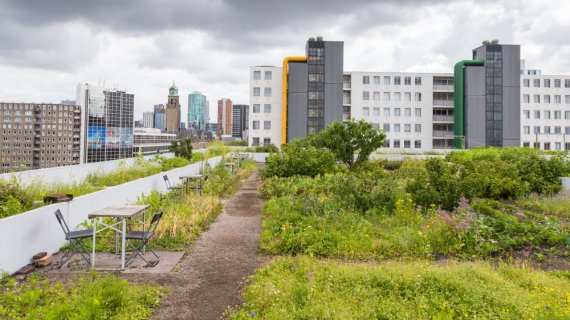Urban agriculture could make good use of human faeces and urine, shows research by environmental technologist Rosanne Wielemakers.
The sustainable use of valuable mineral resources stands or fall with the closing of nutrient cycles. In this context, Rosanne Wielemaker researched how to connect supply and demand for manure in the city. Specifically: how to link urban agriculture with new toilet designs in the city. This combination is still a theoretical exercise at present.
Not permitted
It is not permitted in the Netherlands to use nutrients extracted from human faeces and urine to grow edible products. And what is more, there is no shortage of manure in this country – in fact, quite the opposite. The latter point doesn’t deter Wielemaker. ‘If you live in a country where it rains a lot, you still don’t leave the tap running, do you? This offers possibilities for returning nutrients to agriculture on the smallest scale, with minimal transport costs and losses along the way.’

Wielemaker took Amsterdam as an example. With a model she designed herself, she identified places where the most nutrients can be ‘harvested’, with an emphasis on phosphorus. Countless variables play a role here. Where do people hang out, and for how long, how often do they go to the toilet, and what minerals does that provide? Wielemaker: ‘If you want pure urine, for instance, you’d better go to the Heineken Music Hall.’
Hotspots
She came up with 193 hotspots where a lot of phosphorus is produced. Those places account for 10 per cent of the city’s annual phosphorus load. These are buildings such as the Rijksmuseum, AMC hospital and the flats in the Bijlmer neighbourhood. The model then connected these hotspots with the nearest urban farming locations within the municipality.
Urban overfertilization
The fields of urban farmers are severely overfertilized, shows Wielemaker’s research on the nutrient management on 25 urban farms. On average, the fertilization level was much higher than the crops needed. In figures: 2.5 times too much potassium, 4.5 times too much nitrogen and 6 times too much phosphorus, compared with the application limits for regular agriculture.
It sounds simpler than it is. Within the borders of the municipality there are 2312 agriculture locations, 43 of which count as urban agriculture. Finding the right match depends on a number of factors. Each form of agriculture makes its own demands of the manure it uses, and each source of manure has its own nutrient composition. Bringing supply and demand together is precision work. And that is where there is plenty of work to be done, according to Wielemaker.
Future
In spite of the difficulties, and for now the impossibilities, Wielemaker still sees a future in the combination of urban farming and urban manure. ‘The supply of nutrients such as phosphorus and potassium is finite. In the end we shall need all the available nutrients. In a world that is aiming for circular agriculture, you should close this cycle as well.’

 Photo: Shutterstock
Photo: Shutterstock